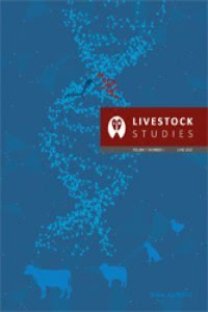Comparison of Two Methods Using Measurement of the Surface Area of M. Longissimus Dorsi (MLD)*
Autocad, Musculus longissimus dorsi, planimeter
___
- 1. AutoCAD (2012): AutoCAD Software. Mill Valley, CA, USA: Autodesk Inc.
- 2. Baskaya R, Karaca T, Sevinc I, Cakmak O, Yıldız A, Yoruk M (2004): The histological, microbiyological and serological quality of ground beef marketed in Istanbul. Van Veterinary Journal, 15(12): 41-46.
- 3. Baulain U (1997): Magnetic resonance imaging for the in vivo determination of body composition in animal science. Computers and Electronics in Agriculture, 17: 189-203.
- 4. Celebi S, Kaya A (2008): The biological properties of conjugated linoleic acid and the studies to increase its level in animal products. Journal of Animal Production, 49(1): 62-68.
- 5. Delgado C (2005): Rising Demand For Meat and Milk In Developing Countries: Implications For Grasslands-based Livestock Production. p: 29-39. In: Grassland: A Global Resource, Edit.: DA McGilloway, Wageningen Academic Publishers, ISBN: 978-9076998-71-8, The Netherlands.
- 6. Fernandez C, Gallego L, Quintanilla A (1997): Lamb fat thickness and longissimus muscle area measured by a computerized ultrasonic system. Small Ruminant Research, 26: 277-282.
- 7. Ferreira OGL, Rossi FD, Coelho RAT, Fucilini VF, Benedetti M (2012): Measurement of rib-eye area by the method of digital images. Revista Brasileira de Zootecnia, 41(3): 811-814.
- 8. Inal T (1992): Besin Hijyeni. Hayvansal Gıdaların Sağlık Kontrolü. Final Ofset. İstanbul.
- 9. Karolyi D, Džidić A, Salajpal K, Đikić M, Jurić I (2006): Comparison of Two Methods for Longissimus Muscle Area Measurements. p:57. 57th Annual Meeting of the European Association for Animal Production, September, 17 – 20, Antalya.
- 10. Minitab (2011): Minitab For Windows Version Release 16, Minitab Inc.
- 11. Moeller SJ, Christian LL (1998): Evaluation of the accuracy of realtime ultrasonic measurements of backfat and loin muscle area in swine using multiple statistical analyses procedures. Journal of Animal Science, 76: 2503-2514.
- 12. Ozbeyaz C (2015): Cattle Breeding, Ankara University Faculty of Veterinary Medicine Department of Animal Science, Lecture Notes, Ankara.
- 13. Smith BS, Jones WR, Hough JD, Huffman DL, Mikel WB, Mulvaney DR (1992): Prediction of carcass characteristics by real time ultrasound in barrows and gilts slaughtered at three weights. Journal of Animal Science, 70: 2304–2308.
- 14. Szabo CS, Babinszky L, Verstegen MWA, Vangen O, Jansman AJM, Kanis E (1999): The application of digital imaging techniques in the in vivo estimation of the body composition of pigs: a review. Livestock Production Science, 60: 1–11.
- 15. Szlavy L, Horvath GY (1993): CT and MR Imaging of the Body, Springer, Budapest, p: 25-38.
- 16. Thornton PK (2010): Livestock production: recent trends, future prospects. Philosophical Transactions: Biological Sciences, 365: 2853-2867.
- 17. Turan SF (2006): A Study On The Identification Of Meat Animal Species According to Carcass Make Up Hair Morphology and Fatty Acid Compositions. MSc. Thesis, Çukurova University, Institute of Science and Technology, Adana.
- 18. Vangen O, Enting H (1990): Intramuscular Fat In Different Duroc Crosses Estimated By Computerised Tomography (CT). In: Meat Quality in Slaughter Animals, Editors: K Lundstrom, G Malmfors, NJF Seminar No. 83, p: 243-252, Norway.
- 19. Yanez EA, Ferreira ACD, Medeiros AN, Pereira Filho JM, Teixeira IAMA, Resende KT (2006): Methodologies for ribeye area determination in goats. Small Ruminant Research, 66: 197-200.
- Yayın Aralığı: 2
- Başlangıç: 1959
- Yayıncı: Sezer ÖZ
Comparison of Two Methods Using Measurement of the Surface Area of M. Longissimus Dorsi (MLD)*
Aykut Asım AKBAŞ, Mehmet SARI, Özkan ELMAZ, Mustafa SAATCI
β-Sinir Büyüme Faktörü’nün Reprodüktif Etkileri
Çeltik Samanının Besin Madde Bileşimi ve Yem Değerini Artırma Yöntemleri
Determination of the Fraud of Processed Meat Products by ELISA
Almanya Orijinli Ankara Tavşanlarında Bazı Yün Özellikleri
Şavak Akkaraman Kuzuların Yetiştirici Koşullarında Büyüme ve Yaşama Gücü Özellikleri
Serdar YAĞCI, Sinan BAŞ, Adile TATLIYER
Yusuf KAPLAN, Zehra BOZKURT, Mustafa TEKERLİ
Vitamin D Yetersizliği ve Obezite
Organik Hayvan Yetiştiriciliğinde Hastalıkların Sağaltımında Kullanılabilecek Maddeler
